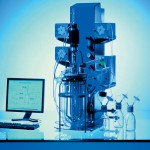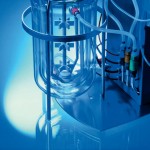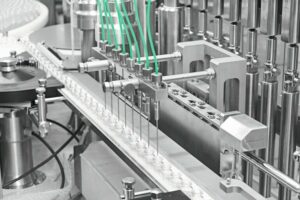Reactor technology has to adapt to the increasing diversification of biotechnological research. The spectrum ranges from the utilisation of extremophile and marine microorganisms through the cultivation of highly sensitive mammalian and plant cells to refolding denatured proteins. Bioengineering’s new autoclavable laboratory fermenter opens up various possibilities for innovative research and development by replacing all stainless steel parts with PEEK, the high-performance thermoplastic. Thanks to PEEK, corrosion and the dissolution of metal traces no longer occur even in the harshest environments.
Dr. Karin Koller
Until recently, biotechnology was practically confined to the utilisation of terrestrial microorganisms. In the meantime, marine or blue biotechnology is increasingly gaining in importance, because many marine microorganisms exhibit unique properties that are suitable for industrial use. The extremophiles are especially interesting. As their name suggests, these bacteria and archaea thrive under extreme conditions, such as very high or very low temperatures, high pressure or very saline atmosphere. They are found in the polar seas, hot volcanic coastal springs, hydrothermal vents, salt lakes, environments with extreme pH and at the bottom of the ocean. One well-known example of the commercial use of an extremophile is the Taq DNA polymerase from Thermus aquaticus. Further potential for thermophilic organisms, their proteins and metabolites exists in the baking, paper and detergent industries. Halophilic organisms produce interesting lipids that could be used for drug delivery systems or cosmetics. Their bacteriorhodopsin could serve to manufacture optical switches or photocurrent generators. Psychrophilic bacteria could yield additives for ice-cream and artificial snow.
Another group of marine organisms of great importance for biotechnology are microalgae. They are single or oligo-cellular, phototrophic and oxygen producing. The main attraction of microalgae currently lies in their long-chain, polyunsaturated fatty acids, antioxidants or antibiotic, antiviral and antitumor properties. In view of the biodiversity of marine microorganisms and the research results obtained so far, we can only speculate about the great potential for developments in this area.
In many cases, relevant proteins are first extracted from the native microorganisms. For industrial manufacturing, however, it is more convenient to utilise genetically transformed organisms such as E. coli because their cultivation is simpler. One major problem with E. coli is the formation of inclusion bodies during protein expression. Inclusion bodies are wrongly folded, denatured protein molecules present in the cell in densely packed, insoluble form. As such, the proteins cannot unleash their full functionality, are consequently useless and significantly lower the process productivity. If correct refolding, and thus the transformation into the active form, is possible, an enormous increase in product yield can be achieved. In addition, the re-combinant protein is produced in very pure form without laborious downstream processing, since in most cases it is by far the most important component of the inclusion bodies. There is no general protocol for refolding. A suitable refolding process must be developed for every protein.
Problem of metal corrosion
Culture and reaction solutions with a high salt content and extreme pH are required in the development of processes for cultivating extremophile and marine microorganisms and refolding inclusion bodies. In most cases, the process cannot do without high chloride ion concentrations. Chloride ions are one of the main causes of corrosion in stainless steel. Corrosion starts with a chloride ion concentration magnitude that is less than the salt content of seawater. The otherwise high corrosion resistance of stainless steel is based on the formation of a passive layer. Even minute damage to the passive layer triggers corrosion. A distinction is made with stainless steel between pitting, intercrystalline, contact, crevice and stress cracking corrosion. Pitting and crevice corrosion are predominant in fermenters and reactors, though only under extreme conditions. Under normal conditions stainless steel vessels for use in biotechnology are manufactured from materials that comply perfectly with the process requirements as well as with the applicable regulations.
High chloride ion concentrations cause pitting corrosion by destroying the passive layer in specific places, leading to tiny pits and holes in the steel. The combination of aggressive media and an insufficient oxygen supply to restore the passive layer leads to crevice corrosion. This form of corrosion mainly occurs in deadlegs and crevices. Although fermentation technology basically avoids such hard-to-reach areas, corrosion under extreme conditions begins in the smallest crevices. Elevated temperature accelerates corrosion. In every biotechnological cultivation process, the vessel contents are heated to 121 °C in order to sterilise the medium and, after the process, deactivate the culture broth. Processes with thermophilic microorganisms require ele-vated temperatures throughout their entire duration. Acid producing microorganisms and iron bacteria also accelerate the corrosion of stainless steel. Due to the reasons stated above, fermentations and reactions with a high salt content cannot be conducted in stainless steel vessels. Reactors made of borosilicate glass are suitable for salty fermentations, especially for research and development purposes. If microalgae are cultured, glass vessels also have the advantage of adequate illumination.
PEEK replaces stainless steel
The major disadvantage of common glass bioreactors is that they cannot manage without stainless steel. The fermenter lids and often also the bottom plate are stainless, as are the ring sparger for aeration, the agitator shaft and impellers, the baffles, the probes and the connectors for media dosage and harvesting the culture broth.
To enable process development in established reactors even under extremely corrosive conditions, Bioengineering has converted Ralf, the autoclavable laboratory fermenter, by replacing all stainless steel parts with PEEK (Polyether Ether Ketone) components. PEEK is a high-performance thermoplastic with good corrosion resistance even in acidic, alkaline and salt-containing solutions. It has a high heat deflection temperature and can thus operate not only at more than 100 °C but also in very low temperatures. PEEK is biocompatible and has been approved by the FDA for food applications. It is therefore ideal for use in biotechnology. In medicine, PEEK is currently employed for implants.
The PEEK-Ralf fermenter is available with volumes from 0.5 to 15 l and is consequently predestined for research, primary upscaling or small-scale production processes.
Owing to its modular design, the laboratory fermenter can be equipped for cultivating extremophile microorganisms in high salt concentrations and at temperatures up to 90 °C as well as for microalgae cultivations with illumination. Sensitive cells can be cultured in this bioreactor without any danger of metal traces. PEEK-Ralf also permits the cultivation of all relatively robust bacteria, yeasts, and animal or plant cells. Since not only the cultivation of microorganisms but also the product recovery need to be conducted under sterile and controlled conditions, refolding of inclusion bodies is likewise possible in this fermenter. PEEK-Ralf is suitable both as a stand-alone bioreactor and as a research station with up to four interlinked fermenters, which are supplied with power centrally but controlled individually. Any standard Ralf can be easily transformed into a PEEK-Ralf and vice versa.
Hall 1, Booth 210
cpp 408
Biotechnica 2008
TechnoPharm 2008
Share:








